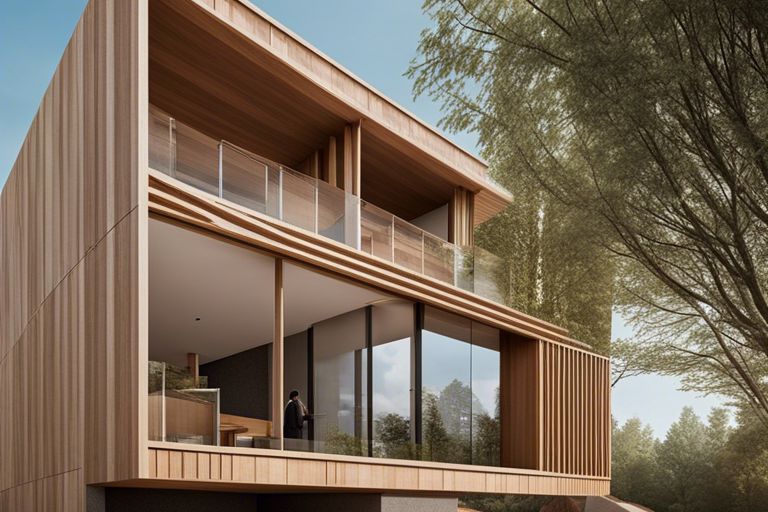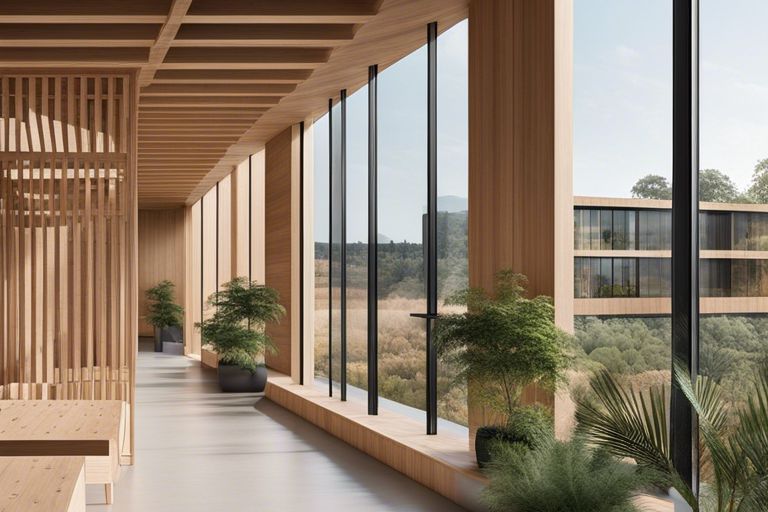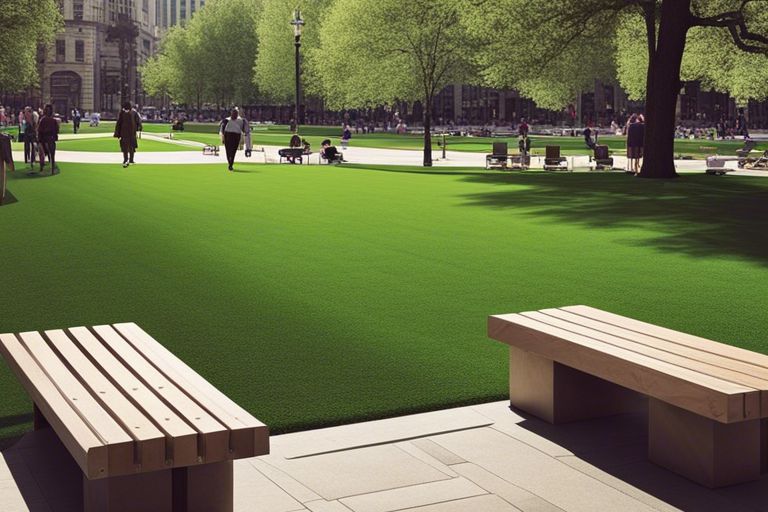There’s a delightful harmony in sustainable construction when eco-friendly materials are used to create biophilic spaces. When you launch on the journey of building or renovating your home, consider incorporating natural elements like reclaimed wood, bamboo, cork, or recycled glass to create a space that not only benefits the environment but also fosters a stronger connection to nature. By choosing eco-friendly materials, you not only reduce your carbon footprint but also contribute to a healthier, more sustainable future for generations to come.

Key Takeaways:
- Sustainable construction: Utilizing eco-friendly materials is crucial for sustainable construction practices.
- Biophilic spaces: Incorporating nature into design helps create healthier and more productive environments.
- Eco-friendly materials: Choosing materials like recycled wood, natural clay, and low VOC paints can significantly reduce environmental impact.
The Importance of Sustainable Construction
Your journey towards sustainable construction begins with understanding the importance of using eco-friendly materials. By opting for sustainable construction practices, you contribute to the preservation of the environment for future generations. Traditional building methods often involve the use of materials that are harmful to the environment, emitting greenhouse gases and depleting natural resources.
Environmental Impact of Traditional Building Materials
The use of traditional building materials like concrete, steel, and bricks has a significant environmental impact. These materials are resource-intensive, requiring large amounts of energy for production and transportation. Concrete production alone accounts for a high percentage of carbon emissions worldwide, contributing to climate change. Additionally, extracting raw materials for traditional building materials can lead to habitat destruction and water pollution.
Benefits of Eco-Friendly Materials in Construction
Sustainable construction offers a myriad of benefits, with the use of eco-friendly materials playing a crucial role. Opting for materials like bamboo, reclaimed wood, and recycled metal can significantly reduce your carbon footprint as these materials require less energy to produce and are often sourced sustainably. Additionally, eco-friendly materials are non-toxic and promote better indoor air quality, creating healthier living environments for you and your family.
Sustainable construction not only benefits the environment but also offers long-term cost savings. Energy-efficient materials can help lower your utility bills and reduce maintenance costs over time, making it a wise investment for the future.
Defining Biophilic Spaces
There’s a growing trend in architecture and design that focuses on integrating nature into built environments, creating spaces that not only look good but also have a positive impact on your well-being. This design approach is known as biophilic design.
The Concept of Biophilia
Biophilic design is based on the concept of biophilia, which suggests that humans have an innate connection to nature and other living beings. Your natural affinity for the natural world can be harnessed to create environments that support your health, productivity, and overall sense of well-being.
Characteristics of Biophilic Design
One of the key characteristics of biophilic design is the incorporation of natural elements, such as plants, natural light, and water, into indoor spaces. These elements not only enhance the aesthetic appeal of a space but also have positive effects on your mood, reducing stress and promoting mental clarity.
Concept: By incorporating biophilic design principles into your living or workspaces, you can create environments that not only look beautiful but also contribute to your overall well-being. From improved air quality to increased feelings of tranquility, embracing biophilic design can truly transform the way you experience your surroundings.
Eco-Friendly Materials for Sustainable Construction
All Biophilic Design Unveiled: Integrating Nature into Sustainable Construction, using eco-friendly materials is paramount in creating sustainable and biophilic spaces. By incorporating materials that have minimal impact on the environment, you can significantly reduce your carbon footprint and create healthier living environments. Let’s explore some of the top eco-friendly materials for sustainable construction.
Recycled and Reclaimed Materials
For sustainable construction, utilizing recycled and reclaimed materials is an excellent way to minimize waste and reduce the need for new resources. Recycled materials such as reclaimed wood, recycled glass, and repurposed metals can add unique character to your space while also being environmentally friendly. By giving these materials a second life in your construction projects, you are contributing to a more sustainable future.
Sustainable Wood Options
Materials such as bamboo, cork, and reclaimed wood are excellent choices for sustainable construction. Materials like bamboo grow quickly and are highly renewable, making them an environmentally friendly alternative to traditional hardwoods. Cork is harvested from the bark of cork oak trees, allowing the trees to continue growing and thriving. Reclaimed wood gives a rustic and unique look to your space while reducing the demand for new timber, thus helping to conserve forests.
Reclaimed wood, in particular, adds a touch of history and charm to your space while also promoting sustainability. Using wood sourced from old buildings, barns, or other structures not only reduces the need for virgin timber but also adds a sense of character and authenticity to your construction project.
Low-Carbon Cement Alternatives
With the Construction industry being a significant contributor to carbon emissions, exploring low-carbon cement alternatives is crucial for sustainable construction. By using materials like fly ash, slag cement, and geopolymer cement, you can reduce the carbon footprint of your construction projects significantly. These alternatives offer similar strength and durability to traditional cement while emitting fewer greenhouse gases during production.
Insulation Materials from Natural Sources
Natural insulation materials such as wool, hemp, and cellulose offer excellent thermal properties while being environmentally friendly. These materials are renewable, biodegradable, and often have low embodied energy compared to synthetic insulation materials. By choosing insulation materials from natural sources, you can improve the energy efficiency of your building while reducing your environmental impact.
Designing Biophilic Spaces with Sustainable Materials
Incorporating Natural Light and Ventilation
To create a biophilic space using sustainable materials, utilize natural light and ventilation to bring the outdoors in. Position your windows strategically to allow for maximum sunlight to flood your space, creating a warm and inviting atmosphere. Additionally, consider incorporating skylights or solar tubes to further enhance the natural lighting in your space. By utilizing natural light, you reduce the need for artificial lighting, lowering your energy consumption and creating a more sustainable environment.
Using Plants and Green Walls
To enhance the biophilic elements in your space, consider incorporating plants and green walls made from sustainable materials such as recycled plastics or reclaimed wood. Plants not only improve air quality by absorbing carbon dioxide and releasing oxygen but also add a touch of nature to your indoor environment. Green walls not only serve as a decorative element but also help improve insulation and regulate humidity levels in your space.
Materials: When choosing plants and green walls for your biophilic space, opt for native species that require minimal maintenance and water. This ensures that your indoor garden remains sustainable and thrives in its environment.
Maximizing Space with Minimal Waste
Green materials such as reclaimed wood, bamboo, or recycled steel can be used to maximize space in your biophilic design while minimizing waste. By incorporating modular furniture or multifunctional pieces made from sustainable materials, you can optimize the layout of your space and reduce the environmental impact of your construction project.
Natural materials such as cork flooring or reclaimed wood accents can also contribute to a more sustainable design by adding warmth and texture to your biophilic space. These materials not only bring a sense of nature indoors but also have positive effects on your health and well-being by reducing exposure to harmful chemicals often found in synthetic materials.
Challenges and Opportunities in Sustainable Construction
Overcoming Cost Barriers
Keep in mind that while incorporating eco-friendly materials into your construction projects may initially seem expensive, the long-term benefits far outweigh the costs. By investing in sustainable materials, you can lower energy bills, reduce maintenance costs, and create healthier environments for occupants.
Addressing Supply Chain Issues
Supply chains can pose a challenge when sourcing eco-friendly materials for your construction projects. It’s important to work closely with suppliers and manufacturers who prioritize sustainability in their processes. This collaboration can help ensure that you have access to high-quality materials that meet both your environmental and performance requirements.
Understanding the impact of global supply chains on the environment is crucial for sustainable construction. By choosing local suppliers whenever possible, you can reduce transportation emissions and support your community’s economy. Additionally, by building strong relationships with suppliers, you can gain insights into their sourcing practices and make more informed decisions about the materials you use.
Government Incentives and Regulations
With government incentives and regulations increasingly supporting sustainable construction practices, you have the opportunity to not only benefit from financial incentives but also to contribute to a greener future. Various programs offer tax credits, rebates, and grants for incorporating eco-friendly elements into your projects, making it more cost-effective to prioritize sustainability.
Challenges may arise when navigating the complex landscape of regulations and incentives, but with the right information and strategies in place, you can leverage these opportunities to enhance the sustainability of your construction projects. By staying informed about changing regulations and actively seeking out incentives, you can stay ahead of the curve and position yourself as a leader in sustainable construction.
Real-World Applications of Sustainable Construction
Residential Buildings
After implementing sustainable construction practices in residential buildings, your home can become a sanctuary that promotes well-being and harmony with nature. By using eco-friendly materials such as bamboo flooring, recycled glass countertops, and low VOC paints, you can create a space that is not only beautiful but also sustainable. These materials not only reduce your carbon footprint but also improve indoor air quality, making your home a healthier place to live.
Commercial Properties
For commercial properties, implementing sustainable construction practices can enhance the overall appeal of your business while also demonstrating social responsibility. Incorporating features such as energy-efficient lighting, green roofs, and recycled building materials can help your company reduce operating costs and attract environmentally conscious customers. Additionally, by utilizing sustainable practices in construction, you can contribute to a greener future and set an example for other businesses.
Sustainable construction in commercial properties not only benefits your business but also has a positive impact on the environment. By reducing energy consumption and waste production, you can help preserve natural resources and create a more sustainable future for generations to come.
Public Spaces and Infrastructure
For public spaces and infrastructure, incorporating sustainable construction practices is imperative for creating healthy and vibrant communities. By using materials such as permeable pavement, energy-efficient lighting, and green spaces, you can create environments that prioritize sustainability and well-being. These features not only enhance the quality of life for residents but also contribute to a more resilient and eco-friendly infrastructure.
Residential buildings can benefit greatly from sustainable construction practices, as they enhance your quality of life while also reducing carbon emissions and environmental impact. By choosing to implement eco-friendly materials and construction techniques, you can create a space that not only looks beautiful but also aligns with your values of sustainability and environmental stewardship.
To wrap up
Drawing together the threads of sustainable construction and utilizing eco-friendly materials for biophilic spaces, it is clear that by incorporating such elements into your building projects, you not only contribute to better environmental practices but also create healthier and more pleasant living or working environments. As you continue to explore ways to integrate nature into your spaces, consider the diverse range of eco-friendly materials that are available to help you achieve your goals.
Be mindful of, every small step towards sustainability and biophilic design can make a difference. By being mindful of the materials you use and the impact they have on the environment, you contribute to a greener future and help create spaces that promote well-being and harmony with nature. Embrace the possibilities that sustainable construction offers and let your commitment to eco-friendly practices shine through in all your building endeavors.
FAQ
Q: What is sustainable construction?
A: Sustainable construction refers to the practice of using environmentally friendly materials and processes to create buildings that have a reduced impact on the environment. This can include utilizing recycled materials, optimizing energy efficiency, and minimizing waste generation.
Q: What are eco-friendly materials in sustainable construction?
A: Eco-friendly materials in sustainable construction are those that are responsibly sourced, renewable, and have a low environmental impact. Examples include bamboo, reclaimed wood, recycled metal, and low VOC paints. These materials help reduce carbon footprint and promote a healthier indoor environment.
Q: How can eco-friendly materials contribute to biophilic spaces?
A: Eco-friendly materials play a crucial role in creating biophilic spaces, which are designed to connect people with nature. By incorporating natural elements like wood, plants, and natural light, along with using sustainable materials, biophilic spaces can enhance occupant well-being, productivity, and overall quality of life.

